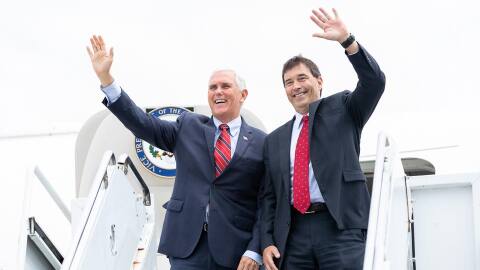Bundled in wool coat and scarf, Danny O’Connor stands outside the entrance to a Pataskala High School football field. It’s senior night, and the announcer introduces each soon-to-be graduate over the PA system.
“Hi folks, how are you,” he says, walking up to a couple loaded down with blankets and bleacher seats. “I’m Danny O’Connor, running for U.S. Congress.”
O’Connor hands out a handful of postcards with Ohio State’s football schedule on one side and a campaign ad on the other. The Democrat is again raising stiff opposition in a district held by Republicans since the early 1980s.
In an August special election for the vacant 12th District seat, less than 2,000 votes separated him from Republican Troy Balderson. That's a far closer margin than the runaway victories enjoyed by both Trump and former Rep. Pat Tiberi in 2016.
“I certainly hope you beat him this time,” the man says, freeing a hand to shake O’Connor’s.
“Thank you, thank you,” O’Connor says, “Would you like a Buckeye schedule to remind you?"
“Just give him one,” the woman says with a grin. “I don’t have any pockets left.”
O’Connor has made pitches like this one a central part of his campaign. He believes football is a way to reach suburban Republicans troubled by President Trump’s rhetoric.

Recalling an Ohio State game in 2016, he says, “We’re racking up touchdown after touchdown, and every touchdown I’m giving a high five to a guy in a Make America Great Again hat. Because for three and a half hours, we weren’t divided.”
So far, O’Connor’s outraised Balderson, amassing a nearly $1 million advantage in their last campaign reporting period. But a Trump-aligned super PAC has erased that margin, putting the same amount into ads attacking O’Connor.
The website FiveThirtyEight still gives the Republican a slight edge, but Ohio State political scientist Paul Beck says that last-minute spending could suggest the GOP is worried.
“That’s probably an indicator that it’s closer than they thought it was going to be, that they’re worried about it, and feel like they need to redouble their efforts to try to take what is a natural Republican district and make sure it stays Republican,” Beck says.
He notes places like Delaware County look different now than they did when district lines were drawn in 2011—more suburban, more highly educated—and that could provide openings for O’Connor. In particular, he explains college educated women are dissatisfied with the President.
“They are voters that are up for grabs in this election,” Beck says. “Again, all over the country, but certainly in the 12th district, and O’Connor may be able to make some inroads with them.”
But even if the national conversation is creating headwinds, Balderson remains confident.

“These are local elections,” Balderson insists. “They’ve become nationalized, but they’re still local elections. And it’s always an honor for me. We’re knocking on doors still.”
While O'Connor continued campaigning immediately after August's special election, Balderson headed to Washington. He thinks the district’s underlying demographics favor his bid, and he believes he’ll actually win more convincingly in November.
Balderson says the special election was just poorly timed.
“You know, there was a county that was just starting its county fair at that time, people were still traveling on their vacations, schools were starting in the following weeks,” Balderson says. “So there was a lot of other activities going outside people’s mindset than a special election, and that’s going to change in November.”
Beck says about 40 percent of registered voters turn out for a typical midterm election. The August special election nearly matched that mark, and the general seems likely to surpass it.
But turnout in rural counties like Marion, Morrow, and Muskingum, where Balderson would presumably have the advantage, lagged in August. At the same time, O’Connor supporters point to precincts near Ohio State where turnout was in the single digits.
Both campaigns expect to pick up a lot of votes in those areas come Election Day.






